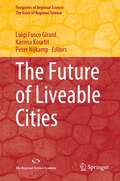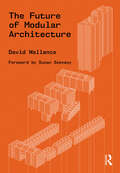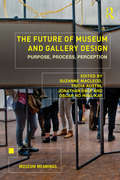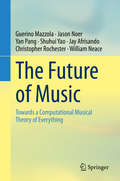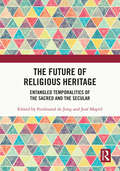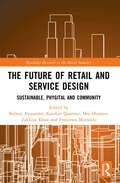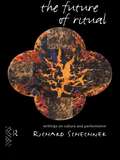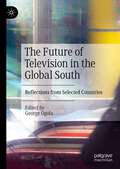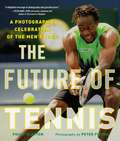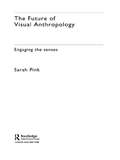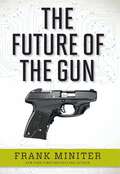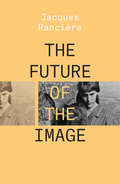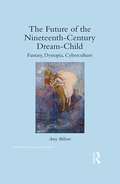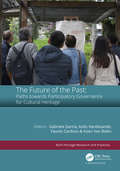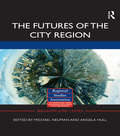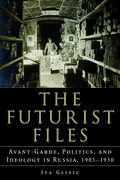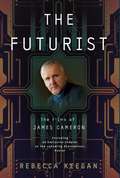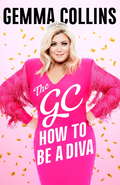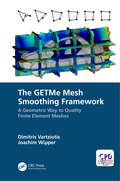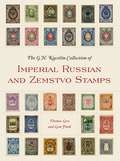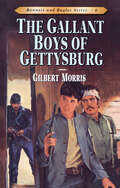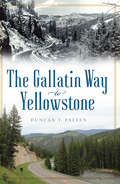- Table View
- List View
The Future of Liveable Cities (Footprints of Regional Science)
by Peter Nijkamp Karima Kourtit Luigi Fusco GirardThis book explores the concept of livable cities, where people enjoy living and being, and examines indicators of citizens' well-being in relation to the urban environment. It is authored by experts from diverse disciplines, providing a citizen-centered perspective on urban well-being in sustainable, environmentally friendly, and climate-neutral (or -positive) cities. The contributions focus on the human and social aspects of cities, developing operational models and frameworks for circular cities, smart resource utilization, and examining contextual factors such as environmental and neighborhood quality, energy transition, climate neutrality, and recycling as factors that influence the well-being of "homo urbanus.” The chapters approach these topics from various analytical perspectives, including conceptual/theoretical, methodological/modeling, policy/planning, and evidence-based case studies. This book will be of interest to scholars in regional and spatial science, urban geography, economics, and related fields, as well as those interested in urban well-being.
The Future of Modular Architecture
by David WallanceThe Future of Modular Architecture presents an unprecedented proposal for mass-customized mid- and high-rise modular housing that can be manufactured and distributed on a global scale. Advocating for the adoption of open-source design based on a new modular standard, the book shows how the construction industry and architectural practice may soon be radically reshaped. By leveraging the existing intermodal freight transport system, global supply chains can be harnessed to realize the long-held promise that housing will be a well-designed and affordable industrial product. We are on the cusp of a transformative change in the way we design and build our cities. Author David Wallance argues that modular architecture is profoundly intertwined with globalization, equitable urbanism, and sustainable development. His book addresses these timely issues through a specific approach grounded in fundamental concepts. Going beyond the individual modular building, Wallance forecasts the emergence of a new type of design, manufacturing, and construction enterprise. Written in an approachable style with illustrated examples, the book is a must read for professionals in architecture and design, city planning, construction, real estate, as well as the general reader with an interest in these topics.
The Future of Museum and Gallery Design: Purpose, Process, Perception (Museum Meanings)
by Suzanne MacLeod Jonathan Hale Tricia Austin Oscar Ho Hing-KayThe Future of Museum and Gallery Design explores new research and practice in museum design. Placing a specific emphasis on social responsibility, in its broadest sense, the book emphasises the need for a greater understanding of the impact of museum design in the experiences of visitors, in the manifestation of the vision and values of museums and galleries, and in the shaping of civic spaces for culture in our shared social world. The chapters included in the book propose a number of innovative approaches to museum design and museum-design research. Collectively, contributors plead for more open and creative ways of making museums, and ask that museums recognize design as a resource to be harnessed towards a form of museum-making that is culturally located and makes a significant contribution to our personal, social, environmental, and economic sustainability. Such an approach demands new ways of conceptualizing museum and gallery design, new ways of acknowledging the potential of design, and new, experimental, and research-led approaches to the shaping of cultural institutions internationally. The Future of Museum and Gallery Design should be of great interest to academics and postgraduate students in the fields of museum studies, gallery studies, and heritage studies, as well as architecture and design, who are interested in understanding more about design as a resource in museums. It should also be of great interest to museum and design practitioners and museum leaders.
The Future of Music: Towards a Computational Musical Theory of Everything
by Guerino Mazzola Yan Pang Jason Noer Shuhui Yao Jay Afrisando Christopher Rochester William NeaceThe idea of this monograph is to present an overview of decisive theoretical, computational, technological, aesthetical, artistic, economical, and sociological directions to create future music. It features a unique insight into dominant scientific and artistic new directions, which are guaranteed by the authors' prominent publications in books, software, musical, and dance productions.Applying recent research results from mathematical and computational music theory and software as well as new ideas of embodiment approaches and non-Western music cultures, this book presents new composition methods and technologies. Mathematical, computational, and semiotic models of artistic presence (imaginary time, gestural creativity) as well as strategies are also covered.This book will be of interest to composers, music technicians, and organizers in the internet-based music industry, who are offered concrete conceptual architectures and tools for their future strategies in musical creativity and production.
The Future of Religious Heritage: Entangled Temporalities of the Sacred and the Secular
by José Mapril Ferdinand De JongThe Future of Religious Heritage examines the resurgence of religious heritage in a secular age and frames such heritage as both legacy from the past and promise for the future. Drawing on case studies from across Europe, the volume addresses the intersection of three well-defined areas of research: secularism, religious heritage, and the question of renewal. Considering the heritagisation of religion and the sacralisation of heritage, contributions to the book consider to what extent the idea of renewal, so pivotal to religious and secular ontologies, is present in heritage formations. Thinking about the temporalities of re-enactment and reconstruction, the volume examines whether heritage practices incorporate religious time into secular practice. Problematising such temporalities of the sacred in our post-secular age, the volume explores how these intersections of religious and secular time in heritage practices inform constructions of the future. The Future of Religious Heritage addresses the paradox of the secularisation of religion and the sacralisation of heritage in a post-secular age. It will appeal to academics and students with an interest in critical heritage studies, religion, and (post)secularism, and will also be of interest to those studying re-enactment, regeneration and renewal.
The Future of Retail and Service Design: Sustainable, Phygital, and Community (Routledge Research in the Retail Industry)
by Katelijn Quartier Bethan Alexander Mia Münster Zakkiya Khan Francesca MurialdoThis book explores the future of retail and service design, offering cutting-edge insights from leading researchers. With a focus on sustainability, phygital innovation, and community retail, it provides a forward-thinking roadmap for the evolution of these fields.Each chapter examines the current landscape and future possibilities, presenting a dynamic vision of what lies ahead. From transforming customer experiences through community engagement and immersive technologies to advancing sustainability, this book invites readers to engage with emerging trends and the transformative power of design.Ideal for researchers, designers, educators, students, and innovation enthusiasts, it delivers fresh perspectives on the rapidly evolving world of retail and service design.Chapter 8 of this book is freely available as a downloadable Open Access PDF at http://www.taylorfrancis.com under a Creative Commons Attribution‑Non Commercial‑No Derivatives (CC‑BY‑NC‑ND) 4.0 license.
The Future of Ritual: Writings on Culture and Performance
by Richard SchechnerIn The Future of Ritual, Richard Schechner explores the nature of ritualised behaviour and its relationship to performance and politics. A brilliant and uncontainable examination of cultural expression and communal action, The Future of Ritual asks pertinent questions about art, theatre and the changing meaning of 'culture' in today's intercultural world. An exciting new work by the author of Performance Theory.
The Future of Television in the Global South: Reflections from Selected Countries
by George OgolaThis book explores how television in the global South is ‘future-proofing’ its continued relevance, addressing its commercial, social and political viability in a constantly changing information ecosystem. The chapter contributions in the book are drawn from countries in East, South and West Africa, the Middle East and Latin America, specially selected for their illustrative potential of the key issues addressed in the book. Scholarly attention on television in the global South has largely been limited to studying evolving television formats with broader structural issues covered almost entirely by industry reports. Major gaps remain in terms of understanding how television in the global South is changing within the context of the significant technological developments and what this means for television’s future(s). The chapters reflect on these futures, not in the sense of predicting what these might be, but rather anticipating important areas of intellection. The contributors contend that much of the scholarship on the global South, by scholars from the South, is often stilted by a reluctance to anticipate. This failure leads to a largely reactionary scholarship, constantly oppositional, and unable to recentre conversations on the South. This volume finds intellectual incentive in this urgent need to anticipate, hence its particular focus on television futures. Taking television in the global South as an important cultural and political barometer, the book seeks to explore how television in the global South is adapting to the rampant technological changes and processes of globalisation.
The Future of Tennis: A Photographic Celebration of the Men's Tour
by Philip Slayton Peter FiguraAt the heart of the men’s tennis game for some years have been the Big Four: Novak Djokovic, Roger Federer, Andy Murray, and Rafael Nadal. Since 2006, only three other players have won a Grand Slam Tournament, and no one else has been ranked world No. 1. But since 2013, the dominance of the Big Four has come under sustained and increasing pressure. New players are challenging Djokovic, Federer, Murray, and Nadal. The rivalry between the old guard and (mostly) young contenders makes this the golden age of tennis. Nick Kyrgios beat Nadal in the fourth round of 2014 Wimbledon. In 2017, David Goffin beat Djokovic in Monte Carlo; Dominic Thiem beat Murray in Barcelona; Sascha Zverev beat Federer in Montreal; and Denis Shapovalov beat Nadal, also in Montreal. In The Future of Tennis Philip Slayton and Peter Figura examine a selection of the players outside of the Big Four and introduce the reader to the great depth of field in the men’s game and the personalities that enliven the sport. Complete with stunning photography by Figura, this book will answer questions about who some of the other players on the tour are, what drives them, their foibles and eccentricities, and more. The perfect gift for tennis aficionados!
The Future of Visual Anthropology: Engaging the Senses
by Sarah PinkFrom an eminent author in the field, The Future of Visual Anthropology develops a new approach to visual anthropology and presents a groundbreaking examination of developments within the field and the way forward for the subdiscipline in the twenty-first century. The explosion of visual media in recent years has generated a wide range of visual and digital technologies which have transformed visual research and analysis. The result is an exciting new interdisciplinary approach of great potential influence for the future of social/cultural anthropology. Sarah Pink argues that this potential can be harnessed by engaging visual anthropology with its wider contexts, including: the increasing use of visual research methods across the social sciences and humanities the growth in popularity of the visual as methodology and object of analysis within mainstream anthropology and applied anthropology the growing interest in 'anthropology of the senses' and media anthropology the development of new visual technologies that allow anthropologists to work in new ways. This book has immense interdisciplinary potential, and is essential reading for students, researchers and practitioners of visual anthropology, media anthropology, visual cultural studies, media studies and sociology.
The Future of the Gun
by Frank MiniterThe history of the American gun is intricately entwined with the history of America itself. Promising developments in gun technology could change not only America's future, but the future of the world. Unfortunately, the radical anti-gun lobby is standing between innovation and the American people. Bestselling author Frank Miniter details the amazing breakthroughs waiting to happen in gun technology that could make today's firearms exponentially safer and smarter-if the anti-gun lobby weren't halting progress in its tracks.In The Future of the Gun, you will learn:Why anti-gun groups often oppose gun safetyfeatures How guns-and gun education for young people-cut crime How federalism could save your gun rights New trends in gun technology that will make guns safer and more effectiveWhy most talk about "assault rifles" is bogus How military and civilian gun technology have always advanced in tandem-for the benefit of soldiers and private citizens What guns could look like in just a few yearsWant to know about the future of guns? There is no better place to start than here.ter, more powerful handguns at prices (when adjusted for inflation) the world has never seen.Taurus, a Brazilian gun maker, played with using 3D printers to make guns over a decade ago. A Texas manufacturer has now made Model 1911 pistols out of steel with 3D printers ... the genie is out of the bottle.
The Future of the Image
by Jacques RanciereLauded by major contemporary artists and philosophers, Jacques Rancière’s work returns politics to its central place in understanding art. In The Future of the Image,Jacques Rancière develops a fascinating new concept of the image incontemporary art, showing how art and politics have always beenintrinsically intertwined. Covering a range of art movements, filmmakers such as Godard and Bresson, andthinkers such as Foucault, Deleuze, Adorno, Barthes, Lyotard andGreenberg, Rancière shows that contemporary theorists of the image aresuffering from religious tendencies.He argues that there is a starkpolitical choice in art: it can either reinforce a radical democracy,or create a new reactionary mysticism. For Rancière there is never apure art: the aesthetic revolution must always embrace egalitarianideals.
The Future of the Nineteenth-Century Dream-Child: Fantasy, Dystopia, Cyberculture (Children's Literature and Culture)
by Amy BilloneThis book investigates the reappearance of the 19th-century dream-child from the Golden Age of Children's Literature, both in the Harry Potter series and in other works that have reached unprecedented levels of popular success today. Discussing Harry Potter as a reincarnation of Lewis Carroll's Alice and J.M. Barrie's Peter Pan, Billone goes on to examine the recent resurrection of Alice in Tim Burton's Alice, and of Peter Pan in Michael Jackson and in James Bond. Visiting trends that have emerged since the Harry Potter series ended, the book studies revisions of the dream-child in texts and films that have inspired mass fandom in the twenty-first century: Stephenie Meyer's Twilight, E.L. James's 50 Shades of Grey and Suzanne Collins's The Hunger Games. The volume argues that the 21st-century desire to achieve dream-states in relationship to eternal youth results from the way that dreams provide a means of realizing the fantastic yet alarming possibility of escaping from time. This current identification with the dream-child stems from the threat of political unrest and economic and environmental collapse as well as from the simultaneous technophilia and technophobia of a culture immersed in the breathless revolution of the digital age. This book not only explores how the dream-child from the past has returned to reflect misgivings about imagined dystopian futures but also reveals how the rebirth of the dream-child opens up possibilities for new narratives where happy endings remain viable against all odds. It will appeal to scholars in a wide variety of fields including Childhood Studies, Children's/YA Literature, Cinema Studies, Cultural Studies, Cyberculture, Gender Studies, Queer Studies, Gothic Studies, New Media, and Popular Culture.
The Future of the Past: Paths towards Participatory Governance for Cultural Heritage
by Gabriela GarcíaThe Future of the Past is a biennial conference generally carried out during the commemoration date of the incorporation of Santa Ana de Los Ríos de Cuenca Ecuador as a World Heritage Site (WHS). It initiated in 2014, organized by the City Preservation Management research project (CPM) of the University of Cuenca, to create a space for dialoguing among interested actors in the cultural heritage field. Since then, this space has served to exchange initiatives and to promote coordinated actions based on shared responsibility, in the local context. The third edition of this conference took place in the context of the 20th anniversary of being listed as WHS and a decade of CPM as the Southern host of the PRECOM³OS UNESCO Chair (Preventive Conservation, Maintenance and Monitoring of Monuments and Sites). For the very first time, and thanks to the collaboration with the Raymond Lemaire International Centre for Conservation of the University of Leuven (Belgium), the conference expanded its local scope. On this occasion, contributions reflected round a worldwide challenge in the cultural field: revealing the paths towards participatory governance of cultural heritage. Participatory governance is understood as institutional decision-making structures supported by shared responsibilities and rights among diverse actors.
The Futures of the City Region: Futures Of The City Region (Regions and Cities)
by Angela Hull Michael NeumanDoes the ‘city region’ constitute a new departure in urbanisation? If so, what are the key elements of that departure? The realities of the urban in the 21st century are increasingly complex and polychromatic. The rise of global networks enabled by supranational administrations, both governmental and corporate, strongly influences and structures the management of urban life. How we conceive the city region has intellectual and practical consequences. First, in helping us grasp rapidly changing realities; and second in facilitating the flow of resources, ideas and learning to enhance the quality of life of citizens. Two themes interweave through this collection, within this broad palette. First are the socio-spatial constructs and their relationship to the empirical evidence of change in the physical and functional aspects of urban form. Second is what they mean for the spatial scales of governance. This latter theme explores territorially based understandings of intervention and the changing set of political concerns in selected case studies. In efforts to address these issues and improve upon knowledge, this collection brings together international scholars building new data-driven, cross-disciplinary theories to create new images of the city region that may prove to supplement if not supplant old ones. The book illustrates the dialectical interplay of theory and fact, time and space, and spatial and institutional which expands on our intellectual grasp of the theoretical debates on ‘city-regions’ through ‘practical knowing’, citing examples from Europe, the United States, Australasia, and beyond. This book was originally published as a Special Issue of Regional Studies.
The Futurist Files: Avant-Garde, Politics, and Ideology in Russia, 1905–1930 (NIU Series in Slavic, East European, and Eurasian Studies)
by Iva GlisicFuturism was Russia's first avant-garde movement. Gatecrashing the Russian public sphere in the early twentieth century, the movement called for the destruction of everything old, so that the past could not hinder the creation of a new, modern society. Over the next two decades, the protagonists of Russian Futurism pursued their goal of modernizing human experience through radical art. The success of this mission has long been the subject of scholarly debate. Critics have often characterized Russian Futurism as an expression of utopian daydreaming by young artists who were unrealistic in their visions of Soviet society and naïve in their comprehension of the Bolshevik political agenda. By tracing the political and ideological evolution of Russian Futurism between 1905 and 1930, Iva Glisic challenges this view, demonstrating that Futurism took a calculated and systematic approach to its contemporary socio-political reality. This approach ultimately allowed Russia's Futurists to devise a unique artistic practice that would later become an integral element of the distinctly Soviet cultural paradigm. Drawing upon a unique combination of archival materials and employing a theoretical framework inspired by the works of philosophers such as Lewis Mumford, Karl Mannheim, Ernst Bloch, Fred Polak, and Slavoj Žižek, The Futurist Files presents Futurists not as blinded idealists, but rather as active and judicious participants in the larger project of building a modern Soviet consciousness. This fascinating study ultimately stands as a reminder that while radical ideas are often dismissed as utopian, and impossible, they did—and can—have a critical role in driving social change. It will be of interest to art historians, cultural historians, and scholars and students of Russian history.
The Futurist: The Life and Films of James Cameron
by Rebecca KeeganWith the release of Avatar in December 2009, James Cameron cements his reputation as king of sci-fi and blockbuster filmmaking. It's a distinction he's long been building, through a directing career that includes such cinematic landmarks as The Terminator, Aliens, The Abyss, and the highest grossing movie of all time, Titanic. The Futurist is the first in-depth look at every aspect of this audacious creative genius-culminating in an exclusive behind-the-scenes glimpse of the making of Avatar, the movie that promises to utterly transform the way motion pictures are created and perceived. As decisive a break with the past as the transition from silents to talkies, Avatar pushes 3-D, live action, and photo-realistic CGI to a new level. It rips through the emotional barrier of the screen to transport the audience to a fabulous new virtual world. With cooperation from the often reclusive Cameron, author Rebecca Keegan has crafted a singularly revealing portrait of the director's life and work. We meet the young truck driver who sees Star Wars and sets out to learn how to make even better movies himself-starting by taking apart the first 35mm camera he rented to see how it works. We observe the neophyte director deciding over lunch with Arnold Schwarzenegger that the ex-body builder turned actor is wrong in every way for the Terminator role as written, but perfect regardless. After the success of The Terminator, Cameron refines his special-effects wizardry with a big-time Hollywood budget in the creation of the relentlessly exciting Aliens. He builds an immense underwater set for The Abyss in the massive containment vessel of an abandoned nuclear power plant-where he pushes his scuba-breathing cast to and sometimes past their physical and emotional breaking points (including a white rat that Cameron saved from drowning by performing CPR). And on the set of Titanic, the director struggles to stay in charge when someone maliciously spikes craft services' mussel chowder with a massive dose of PCP, rendering most of the cast and crew temporarily psychotic. Now, after his movies have earned over $5 billion at the box office, James Cameron is astounding the world with the most expensive, innovative, and ambitious movie of his career. For decades the moviemaker has been ready to tell the Avatar story but was forced to hold off his ambitions until technology caught up with his vision. Going beyond the technical ingenuity and narrative power that Cameron has long demonstrated, Avatar shatters old cinematic paradigms and ushers in a new era of storytelling.
The GC: How to Be a Diva
by Gemma CollinsFor fans of TOWIE, Celebrity Big Brother and Celebs Go Dating, learn how you too can become a diva by the one and only Gemma Collins - one of the greatest gifts reality TV has ever given us.So girls, you alright darlings?By buying this book you will have taken the first steps into a world where everything is fabulous. Men will fall at your feet, riches will be bestowed on you, you will have the biggest, bounciest hair ever and you will get what you want, whatever that is. I'm a diva and I've earned my divaship through many years of hard work, hairdryers and broken hearts. In my book, I'll explore the main themes of the diva lifestyle: attitude, appearance, men and social media. You'll learn what it means to be a diva, how to look like one, how to act like one and how to live like one. At the end of it all, you will be a fabulous diva like me. You'll also learn some very juicy goss about me, my life, the men in my life, shock-induced urinary incontinence and some of the things I've done (including how I sustained an unsightly boob injury in front of Tom Daley while he was wearing a revealing pair of Speedos) (which could probably make a book on its own). So hold on to your extensions, because things are about to get interesting.
The GC: How to Be a Diva
by Gemma CollinsFor fans of TOWIE, Celebrity Big Brother and Celebs Go Dating, learn how you too can become a diva by the one and only Gemma Collins - one of the greatest gifts reality TV has ever given us.So girls, you alright darlings?By buying this book you will have taken the first steps into a world where everything is fabulous. Men will fall at your feet, riches will be bestowed on you, you will have the biggest, bounciest hair ever and you will get what you want, whatever that is. I'm a diva and I've earned my divaship through many years of hard work, hairdryers and broken hearts. In my book, I'll explore the main themes of the diva lifestyle: attitude, appearance, men and social media. You'll learn what it means to be a diva, how to look like one, how to act like one and how to live like one. At the end of it all, you will be a fabulous diva like me. You'll also learn some very juicy goss about me, my life, the men in my life, shock-induced urinary incontinence and some of the things I've done (including how I sustained an unsightly boob injury in front of Tom Daley while he was wearing a revealing pair of Speedos) (which could probably make a book on its own). So hold on to your extensions, because things are about to get interesting.
The GC: How to Be a Diva
by Gemma CollinsFor fans of TOWIE, Celebrity Big Brother and Celebs Go Dating, learn how you too can become a diva by the one and only Gemma Collins - one of the greatest gifts reality TV has ever given us.Gemma Collins burst onto our screens when she joined TOWIE in 2011 and since then she has become renowned for her hilarious one-liners, sassy attitude and, most importantly, memes. Labelled as one of the most iconic women of our nation, her rise to the top has been dazzling.Unafraid to speak her mind with an admirable ability to deal with any situation in style, Gemma has experienced everything from fashion highlights (such as her iconic orange dress) to reminding men that they will never get her candy to being proud of her Essex roots and her body. In How to Be a Diva, the GC will reveal her rise to becoming the nation's meme queen and how you can become one too. She's earned her divaship and, with this book, so can you.(P)2018 Headline Publishing Group Ltd
The GETMe Mesh Smoothing Framework: A Geometric Way to Quality Finite Element Meshes
by Joachim Wipper Dimitris VartziotisHigh quality meshes play a key role in many applications based on digital modeling and simulation. The finite element method is a paragon for such an approach and it is well known that quality meshes can significantly improve computational efficiency and solution accuracy of this method. Therefore, a lot of effort has been put in methods for improving mesh quality. These range from simple geometric approaches, like Laplacian smoothing, with a high computational efficiency but possible low resulting mesh quality, to global optimization-based methods, resulting in an excellent mesh quality at the cost of an increased computational and implementational complexity. <P><P>The geometric element transformation method (GETMe) aims to fill the gap between these two approaches. It is based on geometric mesh element transformations, which iteratively transform polygonal and polyhedral elements into their regular counterparts or into elements with a prescribed shape. GETMe combines a Laplacian smoothing-like computational efficiency with a global optimization-like effectiveness. The method is straightforward to implement and its variants can also be used to improve tangled and anisotropic meshes. <P><P>This book describes the mathematical theory of geometric element transformations as foundation for mesh smoothing. It gives a thorough introduction to GETMe-based mesh smoothing and its algorithms providing a framework to focus on effectively improving key mesh quality aspects. It addresses the improvement of planar, surface, volumetric, mixed, isotropic, and anisotropic meshes and addresses aspects of combining mesh smoothing with topological mesh modification. <P><P>The advantages of GETMe-based mesh smoothing are demonstrated by the example of various numerical tests. These include smoothing of real world meshes from engineering applications as well as smoothing of synthetic meshes for demonstrating key aspects of GETMe-based mesh improvement. Results are compared with those of other smoothing methods in terms of runtime behavior, mesh quality, and resulting finite element solution efficiency and accuracy. <P><P>Features: <li>Helps to improve finite element mesh quality by applying geometry-driven mesh smoothing approaches. <li>Supports the reader in understanding and implementing GETMe-based mesh smoothing. <li>Discusses aspects and properties of GETMe smoothing variants and thus provides guidance for choosing the appropriate mesh improvement algorithm. <li>Addresses smoothing of various mesh types: planar, surface, volumetric, isotropic, anisotropic, non-mixed, and mixed. <li>Provides and analyzes geometric element transformations for polygonal and polyhedral elements with regular and non-regular limits. <li>Includes a broad range of numerical examples and compares results with those of other smoothing methods.
The GH Kaestlin Collection of Imperial Russian and Zemstvo Stamps
by Leon Finik Thomas LeraA quiet philatelist, George H. Kaestlin joined the original Rossika Society in 1935 along with the better known Theo B. Lavroff and K. Szymanowski. Whereas Lavroff contributed significantly to Russian philately as an author and researcher and Szymanowski was an avid collector, Kaestlin collected privately. Born in Moscow, circa 1893, Kaestlin arrived in England in 1939. After World War II, When the original Rossika dissolved, he did not join the newly reconstituted Rossica Society of the United States. He never wrote for any philatelic magazine, never joined the London-based British Society of Russian Philately, and never showed his material at any exhibition. Thus he managed to elude notice in the literature of the times and receded into obscurity. Kaestlin's exceedingly remarkable contribution, however, is found in the quality and scope of his collection and in the preservation of the treasures he acquired (many from the legendary Fabergé collection).Kaestlin's attention to detail and fastidious collecting habits are evident in the layout and handwriting in his albums. His collection, donated to the Smithsonian Institution in 1984 by his niece Vera Madeleine Kaestlin-Bock, includes more than 1,250 album pages on which he organized more than 14,000 Imperial Russian and zemstvo stamps. The quality of the stamps is outstanding. With the publication of this book, Kaestlin can finally take his place among the greats of Russian philately. The G.H. Kaestlin Collection of Imperial Russian and Zemstvo Stamps is one of the greatest museum collections outside of Russia.
The Gallant Boys of Gettysburg (Bonnets and Bugles #6)
by Gilbert MorrisLeah&’s sister Sarah is on her way to that quaint little Pennsylvania town of Gettysburg to help out an old friend. Tom, who is Jeff&’s brother and the soldier Sarah loves, is also headed to Gettysburg, but with the Army of Northern Virginia. Neither of them know that the Northern and Southern troops are about to clash at peaceful little Gettysburg in the bloodiest battle of the Civil War. As Tom fights his way into town, he sees a girl running, threatened by the deadly shells, and is shocked to recognize her as Sarah. Share their fears, their heartbreak. Learn what they learn--that God is with His people even when life gets rough.The Gallant Boys of Gettysburg is the sixth of a ten book series, that tells the story of two close families find themselves on different sides of the Civil War after the fall of Fort Sumter in April 1861. Thirteen year old Leah becomes a helper in the Union army with her father, who hopes to distribute Bibles to the troops. Fourteen year old Jeff becomes a drummer boy in the Confederate Army and struggles with faith while experiencing personal hardship and tragedy. The series follows Leah, Jeff, family, and friends, as they experience hope and God&’s grace through four years of war.
The Gallant Boys of Gettysburg (Bonnets and Bugles #6)
by Gilbert MorrisLeah&’s sister Sarah is on her way to that quaint little Pennsylvania town of Gettysburg to help out an old friend. Tom, who is Jeff&’s brother and the soldier Sarah loves, is also headed to Gettysburg, but with the Army of Northern Virginia. Neither of them know that the Northern and Southern troops are about to clash at peaceful little Gettysburg in the bloodiest battle of the Civil War. As Tom fights his way into town, he sees a girl running, threatened by the deadly shells, and is shocked to recognize her as Sarah. Share their fears, their heartbreak. Learn what they learn--that God is with His people even when life gets rough.The Gallant Boys of Gettysburg is the sixth of a ten book series, that tells the story of two close families find themselves on different sides of the Civil War after the fall of Fort Sumter in April 1861. Thirteen year old Leah becomes a helper in the Union army with her father, who hopes to distribute Bibles to the troops. Fourteen year old Jeff becomes a drummer boy in the Confederate Army and struggles with faith while experiencing personal hardship and tragedy. The series follows Leah, Jeff, family, and friends, as they experience hope and God&’s grace through four years of war.
The Gallatin Way to Yellowstone (Transportation)
by Duncan T. PattenThe Gallatin Way, a picturesque route heading south through the canyon to the west gate of Yellowstone, boasts a history covering more than a century of exploration, homesteading and development. Early pioneers and adventurers endured a rugged and unforgiving terrain where today's travelers speed along a modern highway. One might expect to see dramatic shifts, yet little change is evident in some areas, while others teem with contemporary luxuries. Pairing historic and modern photography of the same locations, Duncan T. Patten retraces the marvel of this iconic thoroughfare.
